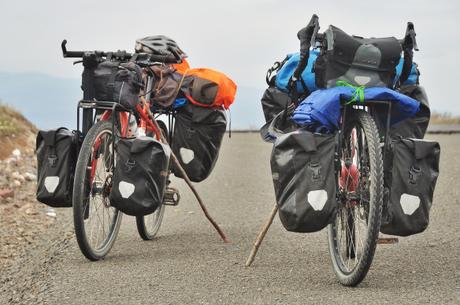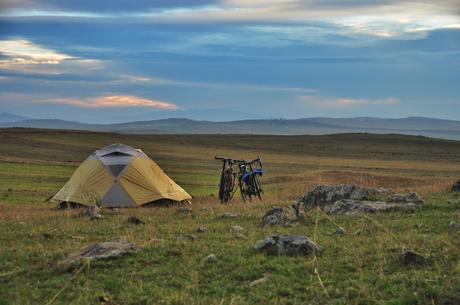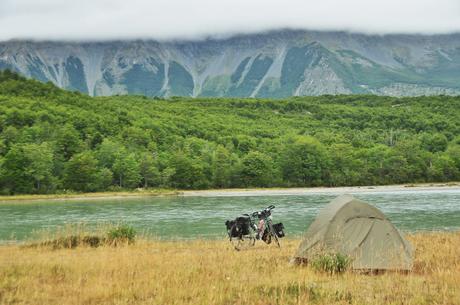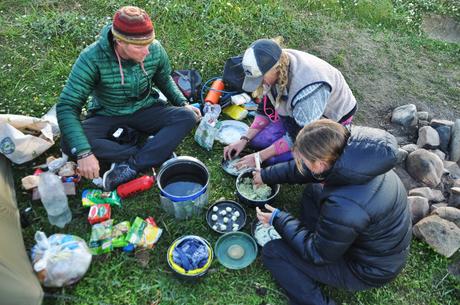“It always rains on tents. Rainstorms will travel thousands of miles, against prevailing winds for the opportunity to rain on a tent.”
Talking about gear doesn’t really interest me which is probably why I’ve almost never written a word about it. That being said, by now I feel like I have a pretty good idea about what works and what doesn’t, at least for us, so I figured I would share our gear list with those of you who, unlike me, are a bit more interested in this side of the lifestyle. Overall, we have been extremely impressed with our gear, and the more we use it, the more we realize that investing money into really high quality stuff is definitely worth it in the long run. We have met tourers who have spent no more than fifty dollars on their gear – which is incredible and proves that anyone can do it – but we have also realized that by spending some money upfront investing in good products it can definitely save you many headaches down the road and allow you to enjoy the ride stress-free.
The Bike (and Accessories): Surly Long Haul Trucker Disc

There is a reason this bike has such amazing reviews and has quickly become one of the most popular touring bikes out there. It is sturdy, simple, and quite honestly, the best bike I could have ever hoped for. That being said, the most important thing about your bike is that it fits, really fits, so get sized and then try it out before you buy one.
Here are a few key highlights (and things I feel you should look for in any world touring bike):
– 26in tires: Universal, unlike 700cc which are uncommon in many parts of the world.
– Steel frame: Sturdy, easy to weld if necessary.
– Disc breaks (BB7): Cyclists will debate this one to the moon and back, but I prefer them because they work better in rain/mud, save your rims from wear and eventual replacement, and are easy to replace as it requires such a small part so you can easily pack a few extras with you and be ready for tens of thousands of kilometers. That being said, either type (mechanical disc or v-breaks) will work.
-Brooks B17 saddle: This hard piece of leather is a legend for a reason. I’ve rarely met a single long term cyclist without one, and it isn’t just because they are stylish.
-Swalbe Marathon Plus Touring Tires: 10,000km without a single flat is the norm with these guys, and at only forty or so bucks a piece, I don’t know why anyone would ever tour with anything else.
-Handlebars: I’ve replaced my original drop down handlebars with butterfly handlebars as they give me more control and hand positions. Kevin has a typical mountain bike straight handlebar with the small end point attachments which he loves as well.
-Cycling gloves: Though mine are in absolute tatters, they still help keep my hands a bit warmer on the downhills, and add padding to the palms of my hands which makes riding all day more comfortable.
As for the racks and bags, we got the bomb proof Surly racks (both front and back) which we are extremely pleased with as it’s impossible to have a single issue with racks that strong, and of course, the Ortlieb panniers, handlebar bags, and one rack pack to share, as they are the sturdiest and most waterproof things out there. Though we haven’t tried them personally, Vaude panniers have also been strongly recommended to us as another option besides Ortlieb, and Tubus racks are another common option if you can’t get Surly.
The Bike Tools/Parts
-Multi tool: There are various good multi tools on the market which have almost everything you need in one single box or piece. Make sure it has a chain remover, a spoke wrench (to true your wheel), and of course various different Allen sizes.
-Cassette remover: Small metal piece which has been worth the investment for us as it’s necessary if you need to remove your cassette (like to fix a back spoke).
-Zip ties: This are one of the most useful things for fixing absolutely everything.
-Wire cutters: They come in handy for cutting extra cable.
-Small wretch: This is necessary for using the cassette remover, as well as for taking off your pedals.
-Old toothbrush and rags for cleaning the chain and bike. Though it seems odd, we have found that gasoline works as a degreaser if you don’t have anything better around.
-Extra disc break pads: They are so small and easy to carry so we usually have a few extra sets with us. On rough dirty roads you end up going through these faster than if you are solely on pavement.
-Extra chain.
-Extra spokes.
-Extra cables and cable housing: For breaks and gears.
-Extra tubes: Though thankfully we have never had a flat.
-Extra lube: When you find some good stuff, stock up cause it’s often hard to find again.
-Extra washers and bolts.
Then there are a few other essential items that are useful for cycle maintenance as well as for general camping or repair.
-Electrical tape
-Duct tape
-Bungees: You can never have too many bungees.
-Pocket knife: For cutting wood, apples, and everything in between.
-Needle and thread
The Tent: Big Agnes Seedhouse 3

Our old large tent.
Though we originally had a huge (and very heavy) car camping three person low-end REI tent, we made the switch to our current home, the Big Agnes Seedhouse 3 lightweight backpacking tent which we love for the most part. It’s light, sturdy, and the perfect size for us, but the zippers have already started to break and after speaking with others with Big Agnes tents, we certainly aren’t the only ones to report this.

Our current tent.
I really don’t know many tents but in general, here are some things to keep in mind:
-Make sure its large enough to accommodate you (and whoever else you plan to be sleeping with) comfortably and make sure you have room to sit up and wiggle around a bit even with some panniers beside you. There may very well be days when it’s raining or snowing so hard that you end up staying in your tent all day, so make sure it’s going to be comfortable. Kevin and I joke that a large tent is the key to traveling as a couple since we simply couldn’t imagine being in one of those tiny two person backpacking tents squished together like sardines after a long sweaty day on the road. When I cycled alone I had a two person backpacking tent which was perfect for just one, and our three person backpacking tent is now perfect for two. The extra few grams are more than worth their weight in happiness!
-Make sure you have a large enough vestibule to comfortably accommodate most if not all of your panniers (depending on how many you plan to keep inside your tent). Large vestibules can also come in handy for cooking in the rain, though don’t blame me if you mess this one up because I know it’s technically a big no-no.
-Tarp: Instead of paying a hundred extra dollars for the real ground sheet, we bought one of those thick blue tarps for about five which we absolutely love. We find our tarp to be an absolute necessity as it keeps the bottom of our tent clean, dry, and hole-free, and because we can throw it down for lunch wherever we happen to be. In fact, for a while in the rainy winter, we even carried two as we used the extra one as a hobo shelter to cook in and as a bike cover at night.
The Sleeping Stuff
-Good sleeping bag: I have a 0F down sleeping bag which I absolutely love as I know that I’ll never be cold no matter how much snow is outside.
-Sleeping pad: I have the Therm-A-Rest Neo Air which is the highest end most comfortable option, and Kevin has the normal Therm-A-Rest which is a little less cool (and much cheaper) but great as well.
-Sleep sheet: These silk/polyester liners are amazing as they give you a few more degrees but more importantly keep your sleeping bag clean. They also are great for when it’s hot out so that you can sleep with a sheet instead of a blanket or when you are sleeping in a dirty bed.
-Pajamas: Meaning clean clothes that you never ever wear out of the tent.
The Cooking Stuff

Making dinner with friends is definitely more fun.
-MSR international whisper-lite stove: Burns everything including petrol which makes it versatile. We carry two fuel bottles which we deem necessary as we are sometimes in regions without many people and therefore no gas stations.
-Pots (2): As a cyclist you are going to eat way more than any normal person, so make sure your pots are big enough to accommodate for this. One of our pot lid’s is plastic which makes it a great cutting board.
-Cutlery: A really good knife is key, as well as a small cheese grater (for potatoes and carrots and such in soups). We also carry a small metal spatula for flipping pancakes, hash browns, and eggs though this one is very optional. We love our sea to summit long handled metal spoon, and our sea to summit metal spork as well.
-Bowls: Our one dollar metal bowls from India have been lovely! As has our small metal cup.
-Water bottles: We each carry two cycling water bottles (1.5L each) as well as three one-liter Nalgenes between the two of us. When cycling through dry countries (like Turkey) we would also strap on an extra cheap three liter water bottle which we would fill in the evenings to cook and clean with.
-Plastic container for left overs.
The Electronics
-Camera: I use a Nikon d5000 with an 18-200 zoom, and I use to also have the Sony RXd100 (a very high end point and shoot) which was amazing because it was discreet yet manual and high quality. If you want to get into photography, I would highly suggest looking into Sony and Canon’s high end nearly professional point and shoot cameras (600-800$) as they really are a travelers dream, and are much smaller and more practical than a bulky DSLR.
-Tablet: We have iPads, though any tablet is great as long as you can download podcasts. This American Life, Radiolab, Tedtalks Radio Hour, and Stuff You Should Know are a few of our favorites.
-Kindle: Kevin recently got me one, and I have no idea how I ever traveled without it. Set up an account with your library before leaving as they now have thousands of free books for loan as e-books.
-Garmin trek30 GPS: This little guy does a great job navigating us through large cities, andshowing us how far we have left to climb. There are open source maps which you can download for free online for anywhere and everywhere.
-Solar Panel: We recently purchased the Goal Zero 120$ solar panel in order to become fully self sufficient. We didn’t need it in Asia as hostels were cheap enough to stay in every week, but in Europe, the USA, and Patagonia, where we are unable to pay for hotel rooms, it’s really come in handy. I would highly suggest getting one with a battery pack as it allows you to capture and store energy during the day to use it at night and because it charges normal batteries (like for headlamps) as well. This is definitely an unnecessary luxury item, but it has come in handy as I try to keep this blog up-to-date.
The Extras
-Water filtration system: Though in Asia we found the steripen to be the easiest way to filter water,in South America we were thankful for our water pump as it allowed us to camp by any river or lake without a second thought.
-Backpacking backpack: My REI flashpack (60L) has a removable frame which means I can stuff it all in my pannier. If not, it’s possible to attach it on the back like a rack pack. Of course this is only if you plan to do some trekking along the way, no use for a backpack while cycling.
-Rope: You can never have too much rope. We use it as a clothes line, to fix things, and to attach water bottles to our bikes when we are out of bungees.
-Headlamp: Just make sure it works.
-Sunglasses: A definite must!
-Toiletries: Besides the obvious (shampoo, toothbrush, soap…) scissors as we have taken to given each other haircuts on the road. The mooncup (or diva cup) is another must have for any of you gals out there, look it up if you haven’t already heard of them. Chapstick is also essential not only for the sun, but also for the wind or cold.
-First Aide Kit: The basics such as band aids, gauze, anti infection creams, Tylenol, second skin, mosquito repellent…
The Clothes
Though I would suggest starting out with clothes you like, I really wouldn’t fret about what your bring because you can find clothes absolutely everywhere in this world! Plus, when you get to a new place you may very well like to change your whole wardrobe based on the local style (like how I started wearing Indian clothes in India to fit in more), based on the weather (it’s a pain carrying tons of warm clothes if your first six months are going to take place across a hot desert), or based on the fact that your current clothes have been torn to shreds by all of the abuse you have put them through. Never the less, I know that some of you will still ask for a list so I’ve bolded the things I actually think you should invest money in (basically the sporty type gear) and think you should understand that your non-cycling clothes are sure to change overtime. As we have cycled through the snow and through 45C alike, we carry a very wide range of clothing which you may not need if your trip is going to be more seasonal.
Warm Weather Clothes
-Cycling shorts (1-2): Be them butt pads or spandex or basket ball shorts, whatever you want to cycle in when it’s warm. One for me has been enough.
-Normal shorts (1): Whatever normal shorts are for you, it’s definitely nice to have a pair of shorts you can walk around cities in without feeling like a cycling hobo. That being said, I didn’t wear shorts for a year straight while I was in Asia so it really depends on your destination. I ended up just buying a pair once I was out of Asia and onto countries where it was appropriate.
-Cycling t-shirt (1-2): I absolutely love my merino wool t-shirt as its comfortable, it never stretches, it doesn’t get cold when wet, and it doesn’t stink as much as normal shirts. I’ve gone through a few of these, though I’m currently happy just wearing one.
-Normal t-shirt (1-2): Probably the only cotton things I have with me.
-Dress (1): Kevin recently admitted that he wished he could wear a dress because it packs up tiny, looks classy and city-like (for when we pretend we aren’t homeless), and is the perfect easy go to outfit for any non-cycling summer day. And in countries were dresses aren’t appropriate, try getting one of whatever the locals wear to make your city exploring days more comfortable.
-Cycling long sleeve shirt (1): Also merino wool (Icebreaker), a wonderful super thin shirt which is good for an under-layer in the winter, or a sun shirt in the summer.
Cold Weather Clothes
-Rain jacket and pants(1): Though they can get expensive, get the best you can afford!
-Long underwear (1): I have thick Underarmor leggings which are great for cycling in cold weather.
-“Trekking” pants (1): Though I didn’t wear them in Asia as I didn’t want to look like a typical tourist (and because it was hot) I absolutely love my high-end, water-resistant, stretchy and comfortable “trekking” pants as they are great for absolutely everything from cycling to wading through rivers to hiking.
-Some sort of wind resistant comfortable jacket which you feel comfortable cycling in and wearing around town. Mine is sort of a soft shell material and it’s proven to be one of the best articles of clothing I have during the winter.
-Huge winter down jacket with hood (mine is from Mountain Equipment Co-op) which will keep you warm no matter what. This is also my pillow.
-Jeans (1): I love my green jeans as I can put them on and walk around a city like a normal person and forget that I actually live in a tent.
All The Time Clothes
-Socks (5): At least two warm wool pairs, and then a few pairs of normal ones.
-Underwear (5+): I started with ten or so, the more the merrier! They are small and light and the more you have the longer you can procrastinate doing laundry.
-Pajamas (1): And by this I mean simply a clean pair of clothes you swear never to wear out of the tent, ever, so that you always have something clean and dry to change into at night.
-Keens (1): Through rain or shine, keens are the best cycling shoes ever. You can walk through rivers and mud without any problem, you can wear them at night as slippers with socks, they let your feet air in the summer but still provide support, and they are extremely comfortable! I would tour with just one pair of shoes, keens, if I was touring without winter.
-Running shoes/hiking boots (1): Great for when it’s colder out, or when you want to hike.
For a photo of the day and other updates follow me on facebook here, and for some awkwardly cropped photos from our journey, follow us on Instagram @awanderingphoto!
